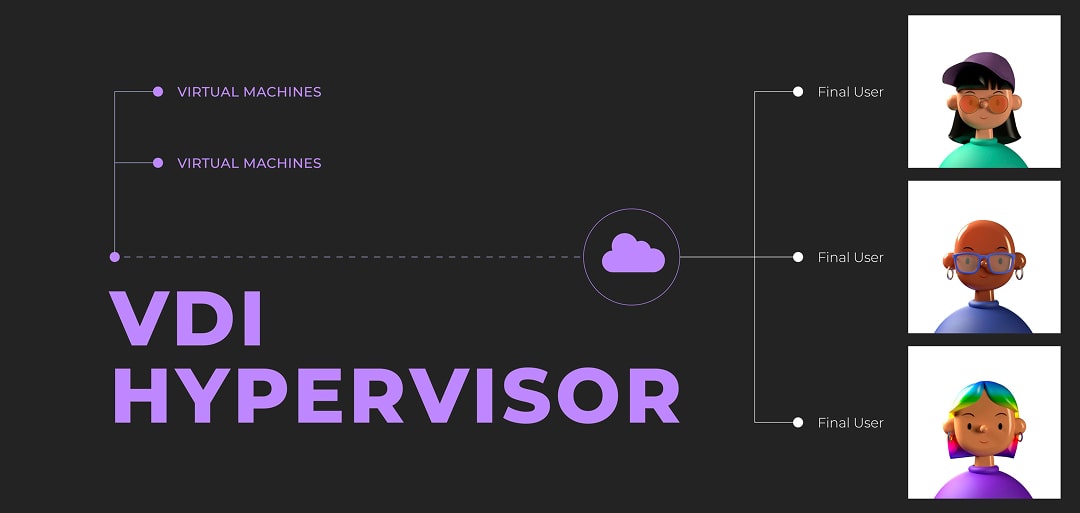By 2024, a number of remote workers is supposed to make 30% of all employees worldwide. In the next year, about 600 million people will be working remotely, which means an increasing challenge for data security. This demand, together with a growing need for mobility and scalability, makes cloud-based virtual desktop infrastructure rise and shine. One of the current leading cloud providers, Amazon Web Services (AWS), reacting to the market demand, is moving desktop virtualization to a Desktop-as-a-Service model.
What is VDI, and How Does it Work?

VDI, or Virtual Desktop Infrastructure, is basically a technology that lets tech teams run multiple operating systems and manage desktops and applications remotely, using a virtual machine. VDI solution is a good solution for users and companies that work with sensitive data, because virtual machines significantly enhance the security level. This is a go-to option for companies that consider outstaffing, because a secure workspace for a remote specialist can be handled easily. Companies that prioritize data protection, security in tech recruitment, working environment flexibility, and safe scaling, can make good use of a VDI technology.
Traditionally, a virtual desktop infrastructure is run by a certain company on their premises, using their data center to give users access to a virtual desktop. This is what major vendors like Citrix usually offer. But there is another deployment model, when VDI is run by a cloud provider or another vendor. This model is known as Desktop-as-a-Service. It's one of the best and most popular examples is Amazon Workspaces.
VDI on AWS: What is Amazon Workspaces?
Amazon Workspaces is a cloud-based service that enables using a Linux or Windows virtual desktop, giving users remote access to applications, files, or services. Storing and processing data, using any of the most popular IDEs, and accessing confidential information are just some processes that become more secure and easier to handle with the AWS virtual workstation.
AWS Workspaces is an example of a Desktop-as-a-Service solution. It enables users to create or access the AWS virtual desktops, accessible from anywhere, and easily manageable. VDI on AWS follows a multi-tenant model, when a host server is shared, eliminating the need for a separate on-premise infrastructure, but all the users have an isolated access to the host.
AWS workstations provide users with the following features:
- Use of applications and software through AWS virtual desktop
- Persistent desktop environments for productivity enhancement
- Consistency of software used to control both virtual workspaces and physical desktops
- Control over which IP addresses are allowed to access a virtual workspace
- Encryption of data without interruption with AWS Key Management Service
- Security enhanced with multifactor authentication
The Amazon Workspaces service was designed to remove a bunch of routine administrative tasks, concerning desktop lifecycle management, such as deployment, provisioning, and maintenance. It strengthens data security, allows establishing a safe working process for remote employees or those who use their personal devices for work. VDI in AWS is especially comfortable for businesses that scale quickly, as it allows adding or removing users quickly.
Using Amazon Workspaces: Best Practices

Knowing what AWS Workspaces is, we need to understand how to use it in a most effective way. Here are some of the best practices for Amazon Workspaces that can help you make the maximum use of the service.
Selecting the right bundle
Amazon Workspaces offers users a high level of flexibility concerning both bundles and pricing models, so they could adjust their services to their business needs. For example, a workspace aimed for just simple tasks, like document creation, requires less memory, and if it is only used a couple of days in a month, customers can only pay for actual hours of work. This makes Amazon Workspaces one of the most cost-effective VDI services.
VPC Design
For successful deployment, Amazon Workspaces requires Amazon VPC (virtual private cloud), which collaborates with each workspace, and at least two subnets. Before creating subnets, you need to consider how many workspaces you are going to need, how many Active Directory domains are going to participate, and where corporate user accounts are going to be stored. Subnets are not resizable, so these questions are worth thinking through beforehand.
Workspace management
The VDI software from Amazon Workspaces is quite user-friendly in terms of workspace launch, configuration, and management, which helps decrease a workload for IT support significantly. Users can perform the following activities for a local client:
- Save credentials and reconnect with the client easily
- Enhance their workspace base and user directory size
- Reboot their workspace
- Change their workspace running mode as needed
- Choose an instance type for a workspace bundle
- Use images to reconstruct their workspace
AWS Virtual Desktop Pricing
How much does it actually cost to host a VDI on AWS? The good news is that Amazon Workspaces do not require large investments to get started. There are two basic AWS workspace pricing models: per hour and per month, with a final price depending on the number of active workspaces and specific software bundles.
Hourly payment
Hourly model is more flexible and suits best for part-time work or short-term usage. The price depends on a user’s region, for example, in the United States it may vary from $0.22 to $1.53 per hour.
Monthly payment
For users who choose Amazon Workspaces as a primary desktop, the monthly model will be a go-to option. In this case, the AWS workspace pricing ranges from $25 to $140 per month, depending on specific resources used.
Wrapping Up
Hosting a VDI on AWS has already proven to be one of the most secure, effective, and budget friendly solutions. Amazon Workspaces is designed for integration into already existing IT systems and processes to let businesses securely scale and add another level of protection while performing a job remotely. The use of Amazon Workspaces helps businesses avoid the hassle of setting up hardware or installing complicated software and delivers an easy user experience with a virtual desktop in just a few clicks.
FAQ
-
Does AWS support VDI?
Amazon Web Services (AWS), as a cloud provider, offers a secure, scalable, and budget-friendly virtual desktop service, Amazon Workspaces. This solution is suitable for businesses that require large-scale virtual desktop infrastructure, and helps them avoid numerous security challenges.
-
Is RDS a VDI solution?
RDS (Remote Desktop Services) and VDI (Virtual Desktop Infrastructure) are both desktop virtualization solutions. They are different in their implementation and maintenance and serve different business purposes. VDI is considered to be more scalable, manageable and customizable, while RDS — more secure and cost-effective.
-
What is the difference between AWS workspace and VDI?
In most cases, VDI is deployed on-premises, using a single tenant model. Whilst Amazon Web Services offers Amazon Workspaces — a cloud-based version of desktop virtualization solution, designed for multiple tenants. It lets different users or companies use a shared host server, without deploying their own virtual desktop infrastructure, while granting separate access to everyone.
Ann Kuss is the CEO at Outstaff Your Team. After 11 years of expertise in building remote tech teams for startup unicorns and global tech brands, Ann decided to lead a new venture aiming to reinvent the way international tech teams scale. Throughout her career, Ann hired specialists for countless tech positions from more than 17 countries on all major continents. Ann graduated from Kyiv-Mohyla business school, is an MIM Kyiv alumna, and regularly takes part in mentorship programs for junior tech talents. Ann actively promotes knowledge sharing and curates Outstaff Your Team blog strategy, preferring topics that solve practical needs of IT leaders. She believes that structuring business flows (including hiring) is a well-planned journey with predictable and successful outcome.



